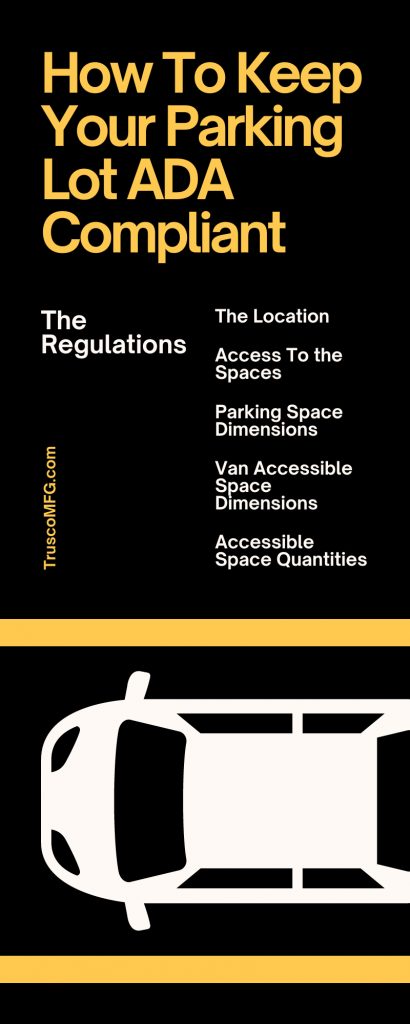
Whether you’re the owner of a private business or the manager of a school or other publicly owned property, maintaining the parking lot is essential to property upkeep. In addition to repairing concrete damage or repainting parking space lines, it’s essential your parking lot is kept ADA Compliant. Here are a few things to keep in mind.
What It Means
ADA is shorthand for the Americans with Disabilities Act. This act protects individuals with disabilities from being discriminated against in many scenarios, especially in the workplace. However, it also ensures that individuals with disabilities can move through the world comfortably.
The ADA ensures that buildings are wheelchair-accessible, entrances and exits are accessible, and parking lots designate the appropriate parking spaces.
Why It Matters
Individuals with disabilities are unable to traverse the world in the same ways as individuals who are able-bodied. It’s an issue that affects a much larger portion of the population than many believe, as 14% of Americans have a mobility disability of some kind.
Having accessible parking near the entrance to your building will create a much safer environment for them, as they won’t need to travel across the entire lot just to reach the door. Traveling such a long distance can be exhausting for some and impossible for others, so it is best to supply accessible parking to meet the needs of those with disabilities.
When working to provide accommodations to individuals with disabilities—in this case, parking space—it’s important to remember that some disabilities are invisible. While it’s easy to see why a person in a wheelchair might need accessible parking, it may not be so obvious in other situations.
For example, many Americans struggle with chronic pain—a disability that is often entirely invisible, except for when they may use mobility aids. Even visible disabilities, such as prosthetic limbs, can go unnoticed when the individual is wearing a long shirt or pants.
Additionally, individuals with disabilities may use mobility aids to make their lives easier, not because they cannot move without them. For example, a large number of wheelchair users can stand or even walk but use their wheelchairs when they need to travel long distances.
This understanding of and empathy for individuals with disabilities is crucial when creating accessible spaces. Understanding the different ways disabilities can appear will allow you to be more accommodating and provide unique accommodations beyond the bare minimum required by the ADA.
The Consequences of Not Performing Upkeep
Of course, the ADA legally requires accessible parking. You and your business may face serious consequences if you do not prioritize creating accessible parking.
The Department of Justice enforces the ADA, which became law over 30 years ago. Penalties for neglecting to create compliant parking spots for individuals with disabilities differ for each state but include fines of up to $150,000.
With such steep consequences on the line, it’s in the best interest of you and your business to just take the time to provide parking spaces that follow the regulations.
The Regulations
These are the legal regulations your building will need to follow to ensure your parking lot is ADA-compliant.
The Location
Create accessible parking spots on the shortest possible path of travel to the entrance of the building. These paths will be right in front of the door for many parking lots. However, it’s important to note that the path of travel in question must be accessible. If the person must walk up a set of stairs to travel from the parking spot to the door, that route is not accessible.
Access To the Spaces
You must make your access aisles available for accessible parking. Access aisles are designated “lanes” for individuals with disabilities to travel through to reach their destination safely and maneuver in and out of their cars easily.
Clearly mark your access aisles, so other drivers understand they aren’t legal parking spaces. They must also be the same length as the parking space they are attached to. An access aisle can be placed between two accessible parking spaces if the spaces are not angled.
Parking Space Dimensions
Having appropriately-sized accessible parking spaces will keep your parking lot ADA-compliant. The spaces must be a minimum of 96 inches wide, with an attached access aisle that is at least 60 inches wide.
The surface must be firm, slip-resistant, and stable to prevent accidents or injuries. Remember to clearly mark the spaces with a sign depicting the international symbol of accessibility. And be sure to place this sign at least 60 inches above the ground.
Van Accessible Space Dimensions
There are two options available for van-accessible dimensions.
Option One:
The space must be at least 132 inches wide, with an access aisle of at least 60 inches. The slope must be minimal and provide a minimum of 98 inches of clearance to allow van access. The surface in and around the parking spot must be slip-resistant, firm, and stable. Mark the space with two signs—the international symbol of accessibility and another sign to indicate the space is van accessible.
Option Two:
The second option must follow all the above requirements, with these differences. The accessible space should be at least 96 inches wide, with an access aisle that is at least 96 inches wide.
Accessible Space Quantities
The number of accessible parking spaces required depends on the size of your parking lot. For example, a parking lot with 25 total spaces requires only one accessible space, while a lot with 150 total spaces requires five accessible parking spots.
For every six accessible parking spaces, at least one of them must be van accessible, and there must be at least one van-accessible space. If you are only required to have one accessible space, that space should be van accessible.
For more information and a chart with specific quantity requirements, check out the resources page on the ADA’s website.
If your lot needs some maintenance to be up to ADA standards, it’s worth investing in a parking lot paint machine to get the job done right. With this guide, your lot will be ADA-compliant in no time.

